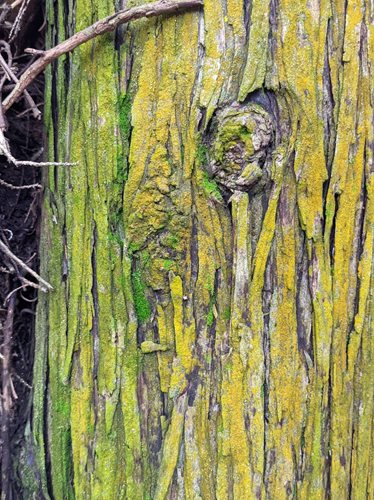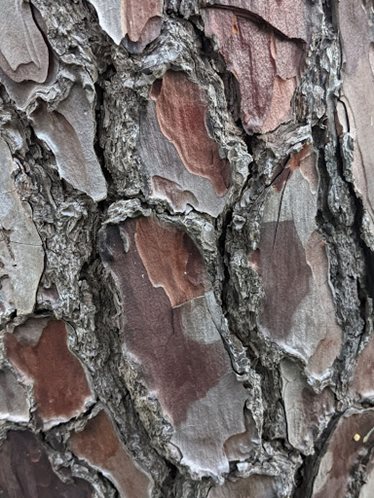By Victoria Mackinlay
As I researched my latest picture book, I became a bark detective — spotting and studying barks around my home and on local bushwalks. The patterns, colours, textures and habitats I found fascinated me. I realised that a simple excursion around the block or to a local park can become an adventure in creativity, texture exploration and art when you open your eyes to the magic of tree barks, and I discovered some interesting facts about trees and bark along the way.
Challenging perceptions - not all barks are brown
If someone asked you to draw a tree trunk right now, you’d probably pick up a brown crayon or pencil. But, if you have a good look at the trees in your neighbourhood, you’ll quickly realise how many different colours and tones there are. Eucalyptus trees often have bluish hues and, if you look at the spots where the bark is peeling, you’ll find phosphorescent blue-green patches underneath.

The varying tones of a eucalyptus tree in my garden
I found this lovely green and yellow tinged bark on a walk through a local park.

Green bark - no filter!
#1 Activity: Share an image of a rainbow eucalyptus and invite children to paint or draw the bark
Rainbow eucalyptus trees (native to the Philippines, Indonesia and Papua New Guinea) are incredible examples of the different coloured tree barks in the world. See if the rainbow eucalyptus images here inspire you to get out the paints and create a magical rainbow forest.
Exploring textures, learning adjectives
You’re most likely aware that some trees are rough while others are smooth, but do you know why?
Barks are a tree’s first line of defence. Rough barks provide habitats for insects and other creatures in their crevices (but they may use chemicals to repel unwanted visitors). Smooth barks — such as beech trees — are intentionally flat to stop insects, animals and creepers climbing them and causing damage.
#2 Activity: Bark textures and describing words
Feeling the bark on different tree trunks can activate our imaginations. The iconic paperbark tree feels spongy to touch, while a banksia tree is knobbly and rough. Get ‘hands on’ with your local trees and discuss different adjectives with children. Take a magnifying glass if you have one available. Also, give them a good sniff! Some barks give off a vanilla or piny scent, whilst some can smell quite unpleasant! Write a list of as many words you can think of together to describe how the bark’s texture looks, feels and smells.
#3 Activity: Making art by rubbing bark
Bark rubbing using paper and wax crayons is a fun sensory activity. Peel the paper wrappers from the crayons and use the crayons on their side, rubbing in a circular motion to avoid the paper tearing.

See how the ‘plates’ on this pine tree’s bark fit together like a magical jigsaw puzzle
Did you know? Naturalists use bark rubbing to monitor the development of trees and for identification. Every tree has a unique bark pattern, just like a fingerprint.
Other fun facts about trees and bark
The writing’s on the … bark
The scribbly gum is one of Australia's most iconic trees, inspiring poets and writers for centuries. Until recently, no one knew the cause of the mysterious zig-zag patterns on the bark. CSIRO scientists discovered they are caused by scribbly gum moth larvae boring tunnels into the bark.

Trees are smart communicators
Trees are regularly given human attributes in classical children’s literature - from the side-taking trees in Narnia to the walking ents in the Lord of the Rings. But how far is fiction from the truth?
Scientists now know that trees can and do communicate with each other through fungi spores in the soil. If a tree is under attack from leaf-eating beetles, it sends messages through its roots to neighbouring trees so they can toughen up their leaves in preparation for an invasion.
The eyes have it
Have you ever walked through a forest and felt like you were being watched? Barks are sometimes decorated with shapes that look like eyes.

#4 Activity: Investigating the uses for bark
Share with children some of the things that Indigenous Australians have used bark for:
- People along the Murray River made canoes from the bark of eucalypts
- Some Indigenous Australians soaked the bark of the blackwood tree (Acacia melanoxylon) in water to bathe painful joints. The inner bark was used to make string
- Bowls and dishes were made from the heavy bark of gum trees (eucalyptus)
- With twine made from kurrajong bark, Aboriginal people of the Hastings River region, NSW, made fishing nets
(Source: Parks Australia)
Ask children: what else could we use bark for to help us in our daily lives?
#5 Activity: Our friends the trees
Invite children to talk about all the things that trees do for us and our planet. Here are some facts to start the discussion:
- Trees release oxygen that we need to breathe
- Trees provide wood
- Trees provide food
- Trees provide a home for many of our animal friends

Peekaboo! Hollows in tree trunks are the perfect place for Rainbow Lorikeet nestsTrees provide shade
THE BARK BOOK - after a question had me stumped, inspiration struck!
When my daughter asked me: “Why do trees have bark and dogs bark?” I didn't have an answer, but I knew I loved both trees and dogs. I also considered how interconnected the two barks are. If you have a dog, you take it for walks, often where there are trees. Dogs also pee on trees. And peeing is funny for children! This was where the concept for THE BARK BOOK began. All the barks mentioned above are beautifully illustrated by Beth Harvey (Bluey’s Animation Director) in THE BARK BOOK, along with an adorable dog going about its daily adventures.

Image @THE BARK BOOK written by Victoria Mackinlay, illustrated by Beth Harvey, published by Harper Collins

The BARK BOOK, illustrated by Bluey’s animation director Beth Harvey, and published by Harper Collins is available in all good bookstores and online now.